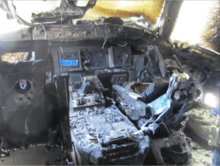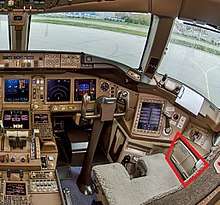EgyptAir Flight 667
.jpg) SU-GBP, the aircraft involved, at London Heathrow Airport. | |
| Incident | |
|---|---|
| Date | 29 July 2011 |
| Summary | Cockpit fire |
| Site | Cairo International Airport |
| Aircraft | |
| Aircraft type | Boeing 777-266ER |
| Aircraft name | Nefertiti |
| Operator | EgyptAir |
| Registration | SU-GBP |
| Flight origin | Cairo International Airport (CAI/HECA) |
| Destination | Jeddah-King Abdulaziz International Airport (JED/OEJN) |
| Passengers | 307 |
| Crew | 10 |
| Fatalities | 0 |
| Injuries | 7 |
| Survivors | 317 (all) |
EgyptAir Flight 667 was a scheduled international passenger flight from Cairo International Airport in Egypt to Jeddah-King Abdulaziz International Airport in Saudi Arabia which suffered a fire in the cockpit while on the ground at Cairo airport on 29 July 2011. Seven people were injured as the aircraft was evacuated. The Boeing 777-200ER aircraft involved was damaged beyond repair and written off.
Aircraft
The aircraft involved was a Boeing 777-266ER, registered SU-GBP (C/N 28423, msn 71). It had first flown on 5 May 1997 and was 14 years old at the time of the accident. It had 48,281 hours of flight time and had completed 11,448 flight cycles.[1]
Accident

The aircraft was parked at gate F7 of Terminal 3 at Cairo airport on 29 July 2011, with preparations underway to operate EgyptAir Flight 667. As the last few of the 307 passengers were boarding, a fire broke out in the cockpit of the Boeing 777, with smoke coming from inside the right side console.[1] According to the testimony provided by the captain and first officer and included in the final report, the fire erupted suddenly.[2]:97, 109
During the final preparation for the flight, and during discussing the last computations, we heard a bang (fissing) sound at the right lower side of the [First Officer] followed by air sound. The [First Officer] jumped out of his seat. I realized that there was a fire at the right side of the F/O. The fire color was yellow with very light blue color.
We were waiting for a late passenger, everything was normal. ... Suddenly, a bang (fissing) sound was heard coming from the right side of my seat. I have seen a crack of about 10 cm long at the side wall to the right of the oxygen mask. I unfastened the seat belt immediately, and stood up very quickly. At the same time, the captain left his seat quickly. The smoke and fire were spreading very quickly. After that, the captain ordered me to get out the cockpit. He started immediately pulling the fire bottle in the cockpit in an attempt to extinguish the fire.
According to the cockpit voice recorder, noises occur at 9:11:38 that the final report characterizes as "a pop is heard, followed by a hissing sound similar to the escape of pressurized gas".[2]:24 Three seconds later, the captain instructs the first officer to "get up, get out now."[2]:24 Twenty-one seconds later, the captain says "fire, fire, call for fire".[2]:24 The fire erupted about 30 minutes after the first officer performed a test of the oxygen mask's function during the standard pre-flight checklist.[2]:97, 109 The passengers were immediately evacuated by the jetbridge.[2]:86
Cairo Civil Defense reported that the aircraft was successfully evacuated with seven injuries. Airport fire teams arrived about three minutes after the fire began and extinguished the fire. Two firefighters were hospitalized for smoke inhalation.[1][3] The aircraft sustained structural damage in the cockpit from the fire as well as extensive heat and smoke damage in the cabin. The aircraft was damaged beyond economic repair; this was the second hull loss of a Boeing 777.[1][3]
Investigation

Since the area where the fire originated has no fuel lines, oil lines, or hydraulic lines, the investigation focused on the crew oxygen supply system as the root cause or a major contributing factor.[2]:59 In the days after the fire, the area of the cockpit where the fire originated on SU-GBP was examined on all EgyptAir 777-200 and 777-300 aircraft. According to the investigation's final report, the wiring found in the oxygen light plate did not match the original Boeing design:[2]:60
The 777-200 aircraft were found to differ from Boeing’s current design. In particular, the wiring to the first officer’s oxygen mask light plate differed in the follow aspects: a wire clamp was missing, the wiring was not sleeved, and a large loop of unsupported wire was found. All of EgyptAir’s 777-200 had a similar wiring configuration at the first officer’s oxygen mask location. The captain’s side wiring was similar, except that sleeving was present on all airplanes inspected. ... On one of the 777-200 aircraft, the outer layer of wiring insulation was found damaged, although the inner layer was intact and the conductor was not exposed.
The reason for the missing clamps could not be determined.[2]:60 Approximately 380 early 777 aircraft did not have sleeves on the wire in the oxygen light.[2]:35 Boeing issued a service bulletin in October 2011 recommending that the oxygen light plate wiring be inspected and, if necessary, have sleeving installed and damaged wires replaced.[2]:61
Testing by the US National Transportation Safety Board following a previous cockpit fire on a Boeing 767 found that flexible oxygen supply hoses could ignite if anti-kink springs along the oxygen supply hose is exposed to an electric current. The hoses in SU-GBP were composed of two layers of silicone with the spring embedded in the outer layer, unlike the hose in the NTSB tests. Testing performed by Boeing on 777 crew oxygen hoses found two of the seven tested to be conductive. Further testing in conditions that increased the likelihood of ignition showed that 5 volts of alternating current was not sufficient to destroy the hose. However, the final report notes that these tests were conducted on new hoses and that Boeing planned to conduct similar tests on older hoses from in-service aircraft to see if any age-related changes could have affected the results.[2]:65
The same test was also performed at voltages and amperage of aircraft wiring found elsewhere in the cockpit. With air in the hose, applying 28 volts AC power at 5 amps of current or 115 volts AC power at 2.5 amps did not rupture the hose or cause ignition, but 28 V AC at 6 amps or 115 V at 5 amps resulted in a small leak with "some incandescence".[2]:42 With oxygen in the tube, 5 V AC at 1.2 amps or 28 V AC at 2.5 amps did not result in a rupture, but 28 V at 5 amps caused a leak "followed by ignition and complete rupture of hose [sic]."[2]:42 Boeing examined the design of the oxygen supply to determine possible sources of electricity:[2]:42
With the exception of the oxygen mask microphone wire (which was found to carry only milliamp level signal currents), all of the wiring in the area of the captain's and first officer's oxygen system followed the design requirements for separation. However, it was determined that contact between aircraft wiring and oxygen system components may be possible if multiple wire clamps are missing or fractured or if wires are incorrectly installed.
Adiabatic heating from the sudden release of pressurized oxygen into the hose was another possible source of ignition, but ruled out. Window grease in an oxygen-rich environment was another source of ignition that was investigated, but testing determined that the oxygen level did not impact the flashpoint, which was over 200°F above the maximum theoretical temperature in that part of the cockpit.[2]:65
The investigation did not conclusively determine the cause of the fire, only that the fire originated near the first officer's oxygen mask supply tubing and that oxygen from the first officer's supply mask "is suspected to have contributed to the fire's intensity and speed",[2]:65 although it is not known whether a breach of the oxygen system provided a flammable environment for the fire to start or whether the oxygen system breached as a result of the fire, and an electrical fault, possibly in anti-kink springs in flexible oxygen supply hoses, may have caused the fire.[2]:65
References
- 1 2 3 4 "EgyptAir Flight 667 ground fire". Aviation Safety Network. Retrieved January 2, 2012.
- 1 2 3 4 5 6 7 8 9 10 11 12 13 14 15 16 17 18 19 20 Aircraft Accident Investigation Central Directorate (September 2012). Final Report Concerning EgyptAir Boeing 777-200 Aircraft Cockpit Fire at Cairo Airport on 29th July 2011, Registration SU-GBP, Flight No MS 667 Cairo/Jeddah (PDF) (Report). Cairo: Aircraft Accident Investigation Central Directorate. Archived (PDF) from the original on March 7, 2016.
- 1 2 "Recent Incidents / Accidents Worldwide". Jet Airliner Crash Data Evaluation Centre. July 2011. Retrieved January 2, 2012.